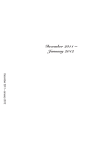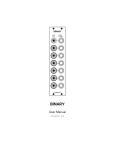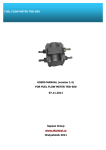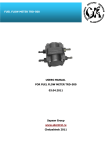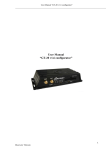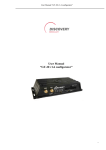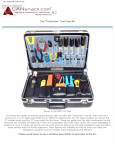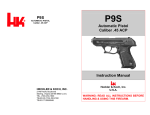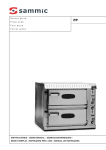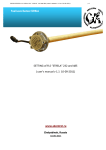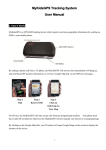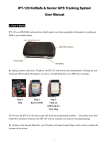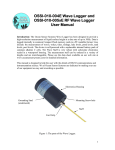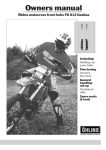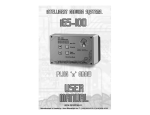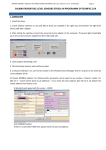Download Fuel level sensors Strela
Transcript
Fuel level sensors Strela - Users manual Fuel level sensors Strela Users manual 10.09.2011 Sapsan Control Co Ltd www.skontrol.ru Russia, Chelyabinsk 2011 Fuel level sensors Strela - Users manual Content Brief description .......................................................................................................................................3 Technical data...........................................................................................................................................4 The short description of sensor product range ...........................................................................................5 Delivery set ..............................................................................................................................................7 Installation of fuel level sensor..................................................................................................................7 Calibration of tank ..................................................................................................................................10 Sensor Strela performance test ................................................................................................................11 Service and application note ...............................................................................................................14 Transportation and storage .................................................................................................................15 Manufacturer’s warranty......................................................................................................................15 Appendix 1. Dimensions.........................................................................................................................16 Fuel level sensors Strela - Users manual Brief description Fuel level sensors STRELA are used for petroleum, oil and lubricants. They enjoy wide application in automotive telematic systems for fuel level recording such as Intellitrac, GoSafe, Enfora, Teltonika. Various interfaces provide a suitable solution for all telematic systems. FLS Strela is a capacitive fuel level sensor without movable parts. Two aluminum tubes create a capacitor plate; its capacity depends from level inside tubes. FLS Strela is not intended for measuring water: with water inside tubes the output signal coincides with that of a full tank. There are different kinds of output signal. You can choose among: • Analog output (0.5-4.5 V, 0.5-3V,0.5-10V,0.5-12V) – Strela A • Frequency output (500-1500 Hz) – Strela F • Digital output (serial RS232 of 485 interface with 1024 or 4096 points resolution) – Strela D232, Strela D485 • Custom interfaces by demand: current 4-20 mA, MODBUS, CAN Electronic components of sensor are immersed into elastic compound that provides maximum protection (IP66) and safety under any operation conditions. Measuring tubes are made of the material that doesn’t react with fuel components. Sensors are adjustable for desired tank height – you may cut them according to the height of your tank. But from fuel lever sensors (FLS for short) Strela A and Strela F you may not cut more than 50% of initial length. There is a list of available initial length of sensors: 180, 250, 350, 400, 500, 600, 700, 1000, 1400, 2000 mm. You should choose from this list the most suitable length for your need; however take the longer one to provide the most accurate length. Strela D232 and Strela D485 can be cut for any height. Sensors have built-in supply voltage stabilizer and sensor output doesn’t depend from onboard voltage. Sensors have built-in algorhythm of data filtration and averaging that allows us to receive smooth fuel data. You can change averaging settings in Strela D232 and Strela D485 sensors. Data averaging in Strela A and Strela F must be defined while making an order before production. Sensors have self-diagnostic capabilities. There are some series of the sensors. For sensors with label PM a body of sensor is electrically not connected with ground. Fuel level sensors Strela - Users manual (version 1.1 10-09-2010) Technical data Table 1 Sensor model -type of signal Strela A1 output Analog, voltage Fuel level 0% Fuel level 100% 2.5 5,7,10* StrelaА3 Strela D232, Strela D485 Analog, Serial resistive(Ohm) interface RS232 or RS 485 Data protocol: Omnicomm, Modbus 800 Ohm, 350 Ohm, 90 Ohm - Strela F Strela PP Frequency, Hz Pulse-packet, pulses, per minute 500 Hz 1500 Hz 500 Pulses/min 1500 Pulses/min - Fuel alarm output 0,5 Ohm Supply voltage, V 10...30 Maximum current, 100 100 50 100 100 mA 1... 20 Distance from lower end from tank after installation, mm Length of 180…2000 and up to 10000 for composite sensors sensor,mm ± 0.1 ± 0.1 ± 0.1 ± 0.3 ± 0.1... ± Measurement 0.025 and error, % of sensor less length Max value of ± 1,0 %. error** Self-diagnostic + + + + feature 30 30 50 30 30 An allowed cutting value, % * On vehicles with 12V onboard circuit voltage can sometimes drop below 10V. In this case sensor will not able to form a signal being that of a full tank – signal will be limited by onboard voltage. We recommend for 12V vehicles to use sensors with 0.5-7V output. ** Error caused by external temperature in range – 400C + 55 0С Table 2 Working temperature,°С Average time before malfunction Тav* Protection class Power consumption, W Dimensions, mm Mass, kg Operation time -40 +65 12500 hours IP66 < 0.2 L x 70 x 70 0.3...3 Not limited Fuel level sensors Strela - Users manual (version 1.1 10-09-2010) The short description of sensor product range FLS Strela А is a widely used fuel level sensor with analog voltage output. Advantages: 1) Voltage output range is extended up to 12 V - it is a MUST for AVL trackers with analog input of 0-24V (Teltonika, and 90% others) 2) No signal pulses above 1-3 mV 3) Self-diagnostic codes 4) Output circuit protection 5) Isolation of sensor body from "ground" power supply - you can connect fuel level sensor directly to car battery. Note: The voltage drop below 10 V is possible on the vehicles with 12 V board electric mains. In that case the sensor is not able to produce signal equal to that of full tank level. The signal will be limited by supply voltage. We recommend to order sensors with maximal output signal up to 7V for vehicle with 12 V board electric mains. FLS Strela A3 should be used in combination with standard fuel level indicators. Sensor Strela A3 can: • Determinate fuel level and produce signal equal to the quantity of fuel in the tank. • Produce signal of minimal balance of the fuel. The sensor may be used in combination with standard fuel level indicators. Equivalent of sensor resistance corresponds to the range 800 Ohm, 350 Ohm, 90 Ohm. As a part of GPS-monitoring system sensor has one fail - the voltage across analog input depends not only on sensor output, but also on standard indicator resistance and board electric mains voltage. Strela F The fuel level sensors Strela F have greater accuracy and indication stability in comparison with Strela A. The tank fuel level is coded by frequency that linearly varies by changing of fuel level. The signal format is meander 50%, pulse height is equal to half of supply voltage. Currently such terminals as GOSAFE support these sensors. Main advantages: ü High resistance to external pickups, poor ground and other interfering signals due to great pulse height ü No loss of data quality on terminal analog to digital converter in compartment with analog output The disadvantage of FLS with pulse output: • As a rule there is a lack of terminal software support Fuel level sensors Strela - Users manual (version 1.1 10-09-2010) Strela PP The fuel level sensors Strela PP have same advantages over Strela A as Strela F. The output signal extends with pulse packet. Packet communication frequency is 1 minute for work mode and 15 seconds for test mode. Pulse count in work mode codes measurable value (from 500 to 1500 pulses). Pulse count in test mode codes error type. Pulse count in packet is over 380 Hz. The signal format is meander 50%; pulse height is equal to the half of supply voltage. Fig. 1.. Format of output signal of FLS Strela PP FLS Strela D232 (D485) The fuel level sensors Strela D 232 (D485) with digital interface RS232 (RS48) are used with record or monitoring systems that have input interface. There are some compatible AVL devices – Intellitrac, Teltonika, DaisyTrack. Digital interface can work with MODBUS protocols or with Omnicomm–compatible protocol. Protocol parameters: 19200 bit per second, 8 bit, 1 stop bit. Resolution - up to 63535 points per length. Main advantages: ü High resistance to external pickups, poor ground and other interfering signals due to great pulse height ü No loss of data quality on terminal analog to digital converter in compartment with analog output Fuel level sensors Strela - Users manual (version 1.1 10-09-2010) Delivery set In the set there are sensor, 4-m cable, gasket, screws, passport Fig. 2 delivery set Installation of fuel level sensor It is recommended to install FLS Strela in the center of tank, in addition to vehicle level sensor. In some cases (when vehicles are used on rugged terrain and tank shape is symmetric) the installation of TWO FLS is recommended. Sometimes FLS Strela can be installed instead of truck level sensor. But in this case you should take into account that: 1. For better measurement the best place for FLS installation is geometric center of the tank (see Fig. 3). Truck level sensor is usually mounted not in the center. 2. FLS Strela have no output on vehicle fuel indicator, you will need FLS gauge unit to connect it to gauge. Fig. 3. Recommended installation scheme Sequence of installation: Fuel level sensors Strela - Users manual (version 1.1 10-09-2010) 1) Drill holes for FLS flange (see fig. 4). Usually bi-metall drill head with 35mm diameter is used. Fig. 4. Bi-metall bore HAWERA Before drilling a hole in a tank with diesel fuel you should refuel it until full. In this case explosive vapor will not produced. If you drill a hole in tank with petrol fuel you should load it with water instead of petrol fuel! It is better to start from central hole, after that insert sensor in hole and mark places for outside 5 holes. They are not symmetric! We use standart hole SAE-5 PIN – see dimensions in Appendix 1). 2) Cut a FLS for desired length with saw – see fig. 5. You should leave about 5-10 mm for water on a bottom of the tank. For Strela A, Strela F: Length of sensor after cutting should be not less than 30 and 50% of initial length accordingly! If your tank needs a shorter sensor – you need Strela with shorter initial length! Fig. 5 Cutting a sensor 3) For Strela D232 or D485 –make a sensor calibration (see instruction of Calibration). Fuel level sensors Strela - Users manual (version 1.1 10-09-2010) 4) According to wiring diagram from passport connect supply voltage, ground and output signal to telematic system. Be aware of incorrect connection – FLS may be burned out! Please follow sensor connection circuit into vehicle electrical system! Don’t mix up cables. Wrong connection may bring sensor out of operation. Don’t apply supply voltage over +30V! Fig. 6 Strela A, Strela F, Strela PP connector and wiring Fig. 7 Strela D232. Strela D485 connector and wiring Table. 1 Strela D232 1 2 3 4 “-” “+” Rx Tx Strela D485 “-” “+” RS-A RS-B Colour brown blue Yellow-green Black Fuel level sensors Strela - Users manual (version 1.1 10-09-2010) Calibration of tank Liters 20 70 130 180 230 280 330 380 440 Sensor output value, Hz 300 370 460 530 600 665 730 795 870 Table 3- an example of tank calibration table The tank calibration consists in recording in the ROM of terminal or AVL software the conversion table of sensor output signal (voltage, frequency, pulses and others) to fuel volume value. Tank calibration technique: 1) Stop vehicle on the flat part of the road (road angularity must minimized). 2) Discharge tank completely. 3) Add fuel till sensor will begin to change indication. Write into table added fuel value. 4) Add in tank by 10-50 liters (lowest value by min and max tank volume, greatest value by half empty tank). Get new proper values of sensor output signal and write down them into the table. Fuel level sensors Strela - Users manual (version 1.1 10-09-2010) Sensor Strela performance test Resistance between pipes works out about 500 kOhm. If value is a sequence less you should check whether there is a contamination between pipes. Strela A1. Without fuel immersion voltage on the working sensor at the output in reference to ground must range from 0.1 to 2.5 V (depending on cutting). Full tank output voltage may be 8 - 10 V (depending on cutting). When sensor touches water diagnostic code is 1.4 V. It is possible to produce versions with decreased output voltage (under order). Table 4. Errors diagnostic codes No 1 2 3 4 5 6 7 8 Code, V Error description 1,0 Sensor is not calibrated at lowest and upper point 1,2 Sensor is not calibrated at upper point Oscillator frequency is equal to 0 (pipe closing against each other particularly 1,4 because of water) 1,6 Divide by zero, sensor was calibrated at the same point 1,8 Reading error EEPROM Break through upper range F> (Fmax+10%) (possible reason is change of fuel 2,0 type or significant water rate in the fuel) 2,2 Break through lowest range F < (Fmin – 10%) 2,4 Calibrating contact point is short-out Strela F. Without fuel immersion signal frequency on working sensor at the output in reference to ground must range from 600 to 700 Hz (depending on cutting). Full tank frequency may be equal to 1300 – 1600 Hz (depending on cutting). When sensor touches water the diagnostic code is 340 Hz. Table 5. Errors diagnostic code No 1 2 3 4 5 6 7 8 Code, sensor output Error description signal, Hz 300 Sensor is not calibrated at lowest and upper point 320 Sensor is not calibrated at upper point Oscillator frequency equal to 0 (pipe closing against each other 340 particularly because of water) 360 Divide by zero, sensor was calibrated at the same point 380 Reading error EEPROM Break through upper range F> (Fmax+10%) (possible reason is 400 change of fuel type or significant water rate in the fuel) 420 Break through lowest range F < (Fmin – 10%) 440 Calibrating contact point is short-out Strela PP. Without fuel immersion pulse packet on working sensor at the output in reference to ground must be 600 – 750 pulses (depending on cutting). Full tank pulse packet must be equal to 4300 – 4600 pulses (depending on cutting). When sensor touches water the diagnostic code is 340 pulses packet. Packet communication frequency is one minute for work mode and 15 seconds for test mode (see fig.1) Fuel level sensors Strela - Users manual (version 1.1 10-09-2010) Table 6. Errors diagnostic code No 1 2 3 4 5 6 7 8 Code, sensor output Error description signal, pulse count 300 Sensor is not calibrated at lowest and upper point 320 Sensor is not calibrated at upper point Oscillator frequency equal to 0 (pipe closing against each 340 other particularly because of water) 360 Divide by zero, sensor was calibrated at the same point 380 Reading error EEPROM Breakthrough upper range F> (Fmax+10%) (possible reason 400 is change of fuel type or significant water rate in the fuel) 420 Breakthrough lowest range F < (Fmin – 10%) 440 Calibrating contact point is short-out Strela D232 and D485. The error codes transfer with protocol (see appendix 2) Table 7. Errors diagnostic code No Code 3 003 5 005 6 006 7 007 Error description Oscillator frequency equal to 0 (pipe closing against each other particularly because of water) Reading error EEPROM Breakthrough upper range F> (Fmax+10%) (possible reason is change of fuel type or significant water rate in the fuel) Breakthrough lowest range F < (Fmin – 10%) Fuel level sensors Strela - Users manual (version 1.1 10-09-2010) Table.8 Causes of error appearance Error Oscillator frequency equal to 0 Reading error EEPROM Breakthrough at upper range F> (Fmax+10%) Working ability Description: oscillator is stopped Works – sensor doesn’t measure fuel level Type of failure: error is of sporadic* (water short-out when vehicle is in motion) or permanent (when mechanical short-circuit occur) nature. After cause is eliminated the sensor passes into work mode. Cause: Sensing element pipes are short-out – water in the fuel, mechanical short-circuit. Failure description Description: set sensor calibration parameters failed. Type: error appears at once when you switch sensor on and has permanent nature, i.e. fuel immersion, wire short-circuits doesn’t effect on sensor output signal. Cause: possible static electricity impact by static electricity while sensor cutting. Description: sensor stands by zero if fuel level is low than gives an error. Type: error occurs on dry sensor. If you submerse sensor into fuel it works properly after it passes dead zone. Cause: more then 10% of noncutting sensor or more than 40% of cutting sensor was cut. The problem may also be caused by damage of sensing element coating. Repair 1. Dry sensor, drain water from the tank; 2. Eliminate mechanical shortcircuit. Check resistance between sensing element pipes when sensor is off by circuit analyzer. Resistance value must range from 460 to 500 k Ohm. doesn’t work Replacement Check: close sensing element electrodes by metallic object, if sensor output signal didn’t change then sensor is out of work. Dead zone below Replacement Check: Submerse sensor into fuel it works properly after it passes dead zone. Fuel level sensors Strela - Users manual (version 1.1 10-09-2010) Breakthrough lowest range F < (Fmin – 10%) Description: fuel level is over real value, sensor gives error from time to time. Type: error occurs at sensor immersion on the level that is close to maximal one or on any other level by water short-out. If error changes to error «Oscillator frequency equal to 0», then the problem is caused by water in the fuel. Cause: measurement fluid is different from diesel fuel or gasoline. Circuit shot of measuring element by water in tank. Works Check: by submersion of sensor into the fuel the output signal is proportional to sinkage. *Sporadic – from time to time. Service and application note ü ü ü ü ü ü ü ü Sensor operation requirements are stated in sensors certificate. To avoid sensor breakdown do not expose sensors to aggressive environments, electromagnetic fields as well as mechanical and weather loads, that exceed determined parameters in the present guide; Do not connect sensor to devices which have interface that fails to meet the specification, indicated in present performance specification and detailed engineering drawings; After sensor installation on vehicle or equipment it is recommended to seal all electrical connections; Sensors repair must be done by qualified staff that has repair right certificate An exterior check is essential before introduction sensors into service. If there are mechanical damages (cracks, shears, dents and etc) at sensor than sensors introduction into service is not allowed; Sensors service must be done by staff that studied the device, its mode of functioning and all instruction indicated in sensor certificate; It is recommended to use proper grade diesel fuel that answer to range of temperature (summer, winter, arctic) to All-Union standard 305. Maintenance support Product does not need maintenance support Maintenance repair Product is nonrepairable. Fuel level sensors Strela - Users manual (version 1.1 10-09-2010) Transportation and storage Transportation The sensors transportation must be done in enclosed transport of any type that can provide protection for sensor against mechanic damage and exclude impact of atmospheric fallout onto pack. By air transport sensors are places in heated pressurized module. The air in vehicles should not contain acid, alkaline and others aggressive addictive agents. Transport package with packed sensor must be sealed. Sealing method should exclude access to packed sensor without removal of the seal. Storage Storage of sensors in the same facility with metal corrosive materials or materials containing aggressive addictive agents is not allowed. Manufacturer’s warranty 1. Guarantee period is 18 month from manufacture data, which is indicated in product certificate. 2. Manufacturer guarantees product working ability under keeping of service rules, transportation and storage rules by customer. 3. Products that have been installed by experts that have received training in Sapsan Export Trade and have personal certification are covered under warranty. 4. Sensors with damage (cracks and shears, dents, impact marks, chamber choking etc) that occured through customer’s fault due to violation of service, storing and transportation terms are not covered under warranty. Fuel level sensors Strela - Users manual Appendix 1. Dimensions

















